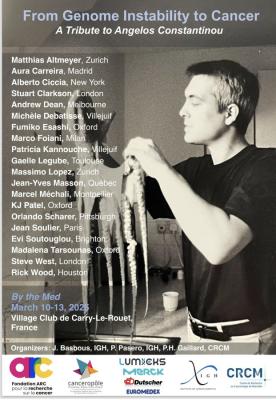Speaker:
Daan Noordermeer
Amphitheater Genopolys

Topologically Associating Domains regulate gene activity by restricting enhancer-promoter loops.Topologically Associating Domains regulate gene activity by restricting enhancer-promoter loops. TADs are formed by loop extrusion and its blocking by CTCF at their boundaries. How optimal separation between TADs is achieved remains incompletely understood. I will present our recent work showing that most TAD boundaries consist of clustered CTCF sites, with each site imperfectly and additively contributing to loop extrusion blocking. Moreover, I will present unpublished biophysical modeling and...
Contact IGH Giacomo CAVALLI
Chromatin and cell biology
Speaker:
Jean Salamero (Institut Curie, France)
Genopolys Amphitheatre
A Deep Learning approach to challenge live imaging of EndoMAMs (endosomal membranes associated with mitochondria)Jean Salamero is an internationally renowned expert in imaging. He led a team at Curie for many years, working on endomembrane trafficking and developping various live, fixed and correlative imaging methods. In addition to his research acitivities, Jean played a major role to develop imaging infrastructures nationwide. He created and developped the Curie imaging facility, he was also a key player for the creation of France-BioImaging and later led this National Infrastructure dedicated to biological...
Contact IGH Edouard BERTRAND
Cell Biology of RNA
Speaker:
Liesbeth Veenhoff (ERIBA, Groningen University, NL)
Genopolys Amphitheatre

The nuclear pore complex in ageing - A landmark structure at the crossroads of genome stability and protein homeostasis.
Contact IGH Charlene BOUMENDIL
Nuclear architecture in physiology and pathology
Speaker:
Dr. Sophie Zinn-Justin (Institute for Integrative Biology of the Cell, CEA, Paris)
Genopolys, Montpellier - France
BRCA2 interactome in meiosis and mitosis: the role of intrinsically disordered regionsTo mitigate the threat of DNA double strand breaks (DSBs), human cells rely on the activity of multiple DNA repair machineries, which are tightly regulated throughout the cell cycle. In G1-phase, DSBs are mainly repaired by non-homologous end joining (NHEJ), whereas in S-phase, when the cell duplicates its genome to get prepared for mitosis, DSBs are repaired by homologous recombination (HR). The Breast CAncer type 2 protein (BRCA2) is a central regulator of HR in most eukaryotes. During HR, BRCA2...
Contact IGH Jihane BASBOUS
You must log in to access IGH staff information
Speaker:
Dr. Manuel Stucki (University of Zurich)
Genopolys, Montpellier - France
Mechanisms of genome stability maintenance during cell divisionThe accurate repair of DNA double-strand breaks (DSBs) is crucial for genome integrity and is tightly regulated during the cell cycle. In mitosis, cells inactivate canonical DSB repair pathways in favor of a DSB tethering mechanism that clusters acentric chromosome fragments in close spatial proximity to ensure their segregation in one of the daughter cells. A complex composed of the adaptor TOPBP1 and the CIP2A protein is critically implicated in chromosome stability maintenance and chromosome fragment...
Contact IGH Jihane BASBOUS
You must log in to access IGH staff information
Speaker:
Dario Lupianez (Centro Andaluz de Biología del Desarrollo, Sevilla, Spain)
Genopolys amphitheater
Seminar of Dario Lupianez - March 1stDario Lupianez, whose laboratory is based in Seville, will be giving a seminar entitled "Genomes in 3D: implications for development and evolution". Dario did his thesis in Raphael Jimenez's laboratory on a very specific model of sex determination: the mole. In 2012, he joined Stefan Mundlos' laboratory for a post-doc where his main research topic was chromatin architecture and disease. In 2017-2023, he joined the Berlin Institute for Medical Systems Biology (BIMSB), Max Delbrück Centre for Molecular...
Contact IGH Francis POULAT
Development and Pathology of the gonad
Speaker:
Dominique Weil (IBPS, Paris)
IGH, Seminar room
What drives the dynamics of RNA storage in P-bodies?P-bodies (PBs) are cytoplasmic membraneless organelles containing untranslated mRNAs, whose functions are poorly understood. In two extreme scenarios, they could either ensure cellular functions by gathering together specific proteins and RNAs in a timely manner, or they could be an epiphenomenon due to intrinsic molecular features of their components. We tackled this issue by purifying human PBs at different phases of the cell cycle. We observed widespread changes in their RNA content: some were...
Contact IGH Edouard BERTRAND
Cell Biology of RNA
Speaker:
Germano CECERE (Institut Pasteur, Paris, France)
Genopolys amphitheater

Small RNAs In Epigenetic InheritanceHeritable traits have long revolved around genomic DNA, yet emerging research redefines our understanding of inheritance. In our laboratory, we embark on a captivating journey into the world of small RNAs and their role in epigenetic inheritance, employing the model organism Caenorhabditis elegans. During my talk, I will unveil the profound influence of small RNAs in trait inheritance. I will present a compelling case study demonstrating how small RNAs gradually reduce fertility across successive...
Contact IGH Giacomo CAVALLI
Chromatin and cell biology
Speaker:
Jan Rehwinkel, PhD
Genopolys amphitheater
Nucleic Acid Sensing by Innate Immune Receptors- A journey from MDA5 to cGAS
Jan is a Professor in the Medical Sciences Division at the University of Oxford. His research focuses on the molecular biology of the activation and regulation of innate immune receptors that survey the cytosol, including the role of nucleic acid sensing in inflammatory diseases and in cancer. Jan is also interested in the molecular mechanisms underlying host-pathogen interactions. His work lies at the intersection of immunology, virology and molecular biology.
Contact IGH Yea-Lih LIN
Speaker:
Bennett Van Houten (UPMC-Hillman Cancer Center, PA, USA)
Genopolys, Room Rotonde
A new single molecule approach to study DNA repair protein dynamics: seeing is believingThis seminar will present a new rapid and robust method for single molecule analysis of DNA binding proteins from nuclear extracts (SMADNE) of human cells expressing a fluorescently tagged protein of interest (Schaich et al., Nucleic Acids Res. 2023 Apr 24;51(7):e39). SMADNE when combined with the LUMICKS C-trap provides unprecedented observations of DNA repair protein dynamics on damaged DNA. Over the last 18 months our group has been able to analyze the dwell times of 30 proteins or protein variants...
Contact IGH Jihane BASBOUS
Genetic Instability and Cancer


